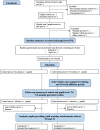Protocol for a cluster randomised controlled trial of a Peer-Led physical Activity iNtervention for Adolescent girls (PLAN-A)
- PMID: 31138171
- PMCID: PMC6537278
- DOI: 10.1186/s12889-019-7012-x
Protocol for a cluster randomised controlled trial of a Peer-Led physical Activity iNtervention for Adolescent girls (PLAN-A)
Abstract
Background: Adolescent girls are less physically active than recommended for health, and levels decline further as they approach adulthood. Peers can influence adolescent girls' physical activity. Interventions capitalising on peer support could positively impact physical activity behaviour in this group. Building on promising feasibility work, the purpose of this cluster randomised controlled trial is to assess whether the Peer-Led physical Activity iNtervention for Adolescent girls (PLAN-A) increases adolescent girls' physical activity and is cost effective.
Methods: PLAN-A is a two-arm secondary school-based cluster randomised controlled trial, conducted with girls aged 13-14 years from twenty schools in the south west of England. The intervention requires participants to nominate influential girls within their year group to become peer supporters. The top 15% of girls nominated in each school receive three days of training designed to prepare them to support their peers to be more physically active during a ten-week intervention period. Data will be collected at two time points, at baseline (T0) and 5-6 months post-intervention (T1). Schools will be randomly allocated to the intervention (n = 10) or control (n = 10) arm after T0. At each time point, all consenting participants will wear an accelerometer for seven days to assess the primary outcome of mean weekday minutes of moderate-to-vigorous physical activity. Multivariable mixed effects linear regression will be used to estimate differences in the primary outcome between the two arms and will be examined on an Intention-to-Treat (ITT) basis. A self-report psychosocial questionnaire will be completed by participants to assess self-esteem and physical activity motivation. Resource use and quality of life will be measured for the purposes of an economic evaluation. A mixed-methods process evaluation will be conducted to explore intervention fidelity, acceptability and sustainability. Analysis of quantitative process evaluation data will be descriptive, and the framework method will be used to analyse qualitative data.
Discussion: This paper describes the protocol for the PLAN-A cluster randomised controlled trial, a novel approach to increasing adolescent girls' physical activity levels through peer support.
Trial registration: ISRCTN14539759-31 May, 2018.
Keywords: Adolescent girls; Intervention; Peers; Physical activity; School.
Conflict of interest statement
The authors declare that they have no competing interests.
References
-
- Ortega FB, Ruiz JR, Hurtig-Wennlof A, Vicente-Rodriguez G, Rizzo NS, Castillo MJ, et al. Cardiovascular fitness modifies the associations between physical activity and abdominal adiposity in children and adolescents: the European youth heart study. Br J Sports Med. 2010;44(4):256–262. doi: 10.1136/bjsm.2008.046391. - DOI - PubMed
Publication types
MeSH terms
Grants and funding
LinkOut - more resources
Full Text Sources
Medical


